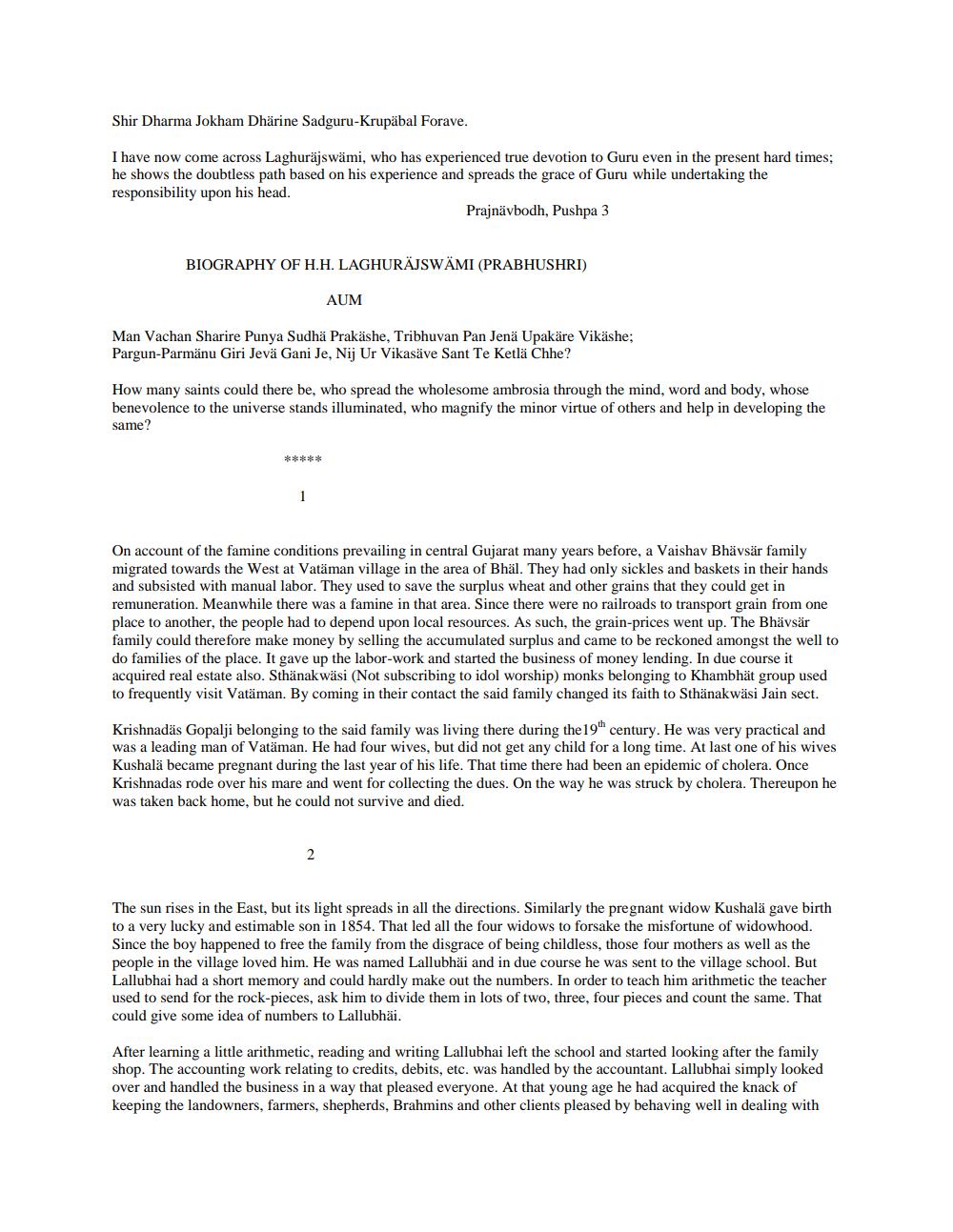Book Title: Laghurajswami Biography Author(s): Manu Doshi Publisher: Manu Doshi View full book textPage 2
________________ Shir Dharma Jokham Dhärine Sadguru-Krupabal Forave. I have now come across Laghuräjswämi, who has experienced true devotion to Guru even in the present hard times; he shows the doubtless path based on his experience and spreads the grace of Guru while undertaking the responsibility upon his head. Prajnävbodh, Pushpa 3 BIOGRAPHY OF H.H. LAGHURÄJSWÄMI (PRABHUSHRI) AUM Man Vachan Sharire Punya Sudhä Prakashe, Tribhuvan Pan Jenä Upakäre Vikäshe; Pargun-Parmänu Giri Jevä Gani Je, Nij Ur Vikasäve Sant Te Ketlä Chhe? How many saints could there be, who spread the wholesome ambrosia through the mind, word and body, whose benevolence to the universe stands illuminated, who magnify the minor virtue of others and help in developing the same? * On account of the famine conditions prevailing in central Gujarat many years before, a Vaishav Bhävsär family migrated towards the West at Vataman village in the area of Bhäl. They had only sickles and baskets in their hands and subsisted with manual labor. They used to save the surplus wheat and other grains that they could get in remuneration. Meanwhile there was a famine in that area. Since there were no railroads to transport grain from one place to another, the people had to depend upon local resources. As such, the grain-prices went up. The Bhävsär family could therefore make money by selling the accumulated surplus and came to be reckoned amongst the well to do families of the place. It gave up the labor-work and started the business of money lending. In due course it acquired real estate also. Sthänakwäsi (Not subscribing to idol worship) monks belonging to Khambhät group used to frequently visit Vataman. By coming in their contact the said family changed its faith to Sthänakwäsi Jain sect. Krishnadäs Gopalji belonging to the said family was living there during the 19" century. He was very practical and was a leading man of Vataman. He had four wives, but did not get any child for a long time. At last one of his wives Kushalä became pregnant during the last year of his life. That time there had been an epidemic of cholera. Once Krishnadas rode over his mare and went for collecting the dues. On the way he was struck by cholera. Thereupon he was taken back home, but he could not survive and died. The sun rises in the East, but its light spreads in all the directions. Similarly the pregnant widow Kushalä gave birth to a very lucky and estimable son in 1854. That led all the four widows to forsake the misfortune of widowhood. Since the boy happened to free the family from the disgrace of being childless, those four mothers as well as the people in the village loved him. He was named Lallubhäi and in due course he was sent to the village school. But Lallubhai had a short memory and could hardly make out the numbers. In order to teach him arithmetic the teacher used to send for the rock-pieces, ask him to divide them in lots of two, three, four pieces and count the same. That could give some idea of numbers to Lallubhäi. After learning a little arithmetic, reading and writing Lallubhai left the school and started looking after the family shop. The accounting work relating to credits, debits, etc. was handled by the accountant. Lallubhai simply looked over and handled the business in a way that pleased everyone. At that young age he had acquired the knack of keeping the landowners, farmers, shepherds, Brahmins and other clients pleased by behaving well in dealing withPage Navigation
1 2 3 4 5 6 7 8 9 10 11 12 13 14 15 16 17 18 19 20 21 22 ... 49
